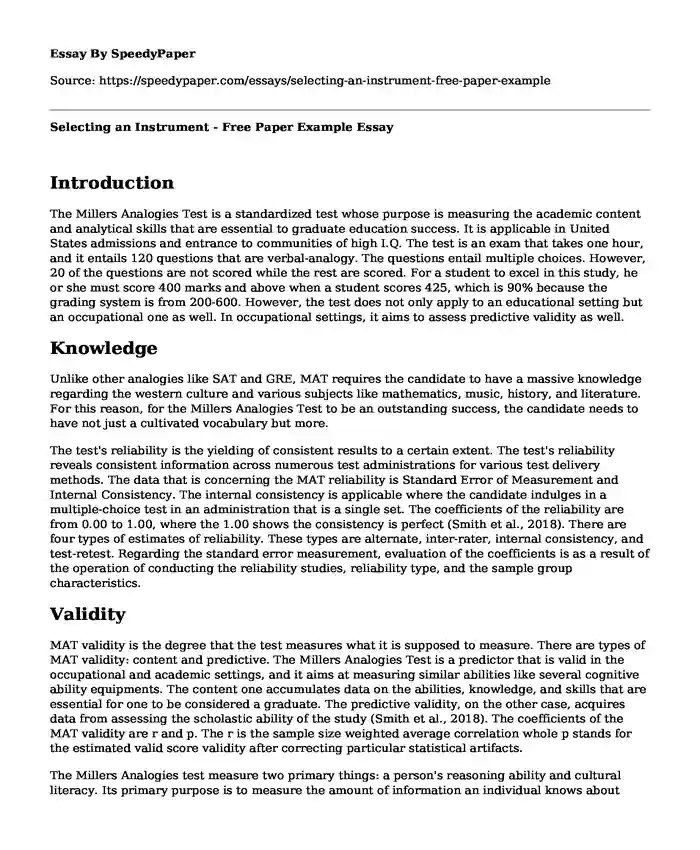
| Type of paper: | Essay |
| Categories: | Education Analysis Admission help |
| Pages: | 3 |
| Wordcount: | 770 words |
Introduction
The Millers Analogies Test is a standardized test whose purpose is measuring the academic content and analytical skills that are essential to graduate education success. It is applicable in United States admissions and entrance to communities of high I.Q. The test is an exam that takes one hour, and it entails 120 questions that are verbal-analogy. The questions entail multiple choices. However, 20 of the questions are not scored while the rest are scored. For a student to excel in this study, he or she must score 400 marks and above when a student scores 425, which is 90% because the grading system is from 200-600. However, the test does not only apply to an educational setting but an occupational one as well. In occupational settings, it aims to assess predictive validity as well.
Knowledge
Unlike other analogies like SAT and GRE, MAT requires the candidate to have a massive knowledge regarding the western culture and various subjects like mathematics, music, history, and literature. For this reason, for the Millers Analogies Test to be an outstanding success, the candidate needs to have not just a cultivated vocabulary but more.
The test's reliability is the yielding of consistent results to a certain extent. The test's reliability reveals consistent information across numerous test administrations for various test delivery methods. The data that is concerning the MAT reliability is Standard Error of Measurement and Internal Consistency. The internal consistency is applicable where the candidate indulges in a multiple-choice test in an administration that is a single set. The coefficients of the reliability are from 0.00 to 1.00, where the 1.00 shows the consistency is perfect (Smith et al., 2018). There are four types of estimates of reliability. These types are alternate, inter-rater, internal consistency, and test-retest. Regarding the standard error measurement, evaluation of the coefficients is as a result of the operation of conducting the reliability studies, reliability type, and the sample group characteristics.
Validity
MAT validity is the degree that the test measures what it is supposed to measure. There are types of MAT validity: content and predictive. The Millers Analogies Test is a predictor that is valid in the occupational and academic settings, and it aims at measuring similar abilities like several cognitive ability equipments. The content one accumulates data on the abilities, knowledge, and skills that are essential for one to be considered a graduate. The predictive validity, on the other case, acquires data from assessing the scholastic ability of the study (Smith et al., 2018). The coefficients of the MAT validity are r and p. The r is the sample size weighted average correlation whole p stands for the estimated valid score validity after correcting particular statistical artifacts.
The Millers Analogies test measure two primary things: a person's reasoning ability and cultural literacy. Its primary purpose is to measure the amount of information an individual knows about certain subjects and the ability to connect the concepts from the subjects. Also, it predicts how a student will perform in the graduate institution (Gladkova et al., 2016). The Millers Analogies Test is not only applicable in an occupational setting but an educational one as well. However, the main interest is on how it helps a client in an educational setting. The first way in which the test helps people in an educational setting is that it helps in recognizing the abilities and knowledge of the candidates that go above repeating information and memorizing. The second one is that it assists the candidates when they are applying for various programs in institutions that consider the Millers Analogies Test. The final one is that the analogies of the test contain knowledge that has been acquired from life experiences.
Conclusion
In conclusion, the Millers Analogies Test is of significance because it measures the academic content and analytical skills of students to ensure their success in education. It is also essential because it ensures the student knows the information on the subject and how to connect it to its concepts. The Millers Analogies Test is applicable in an educational setting because it tests the student's knowledge, teach them the life experiences, and helps the students when they are applying for different programs in different institutes that apply the test.
References
Gladkova, A., Drozd, A., & Matsuoka, S. (2016, June). Analogy-based detection of morphological and semantic relations with word embeddings: what works and what does not. In Proceedings of the NAACL Student Research Workshop (pp. 8-15).
https://www.aclweb.org/anthology/N16-2002.pdf
Smith, A. D., Refsum, H., Bottiglieri, T., Fenech, M., Hooshmand, B., McCaddon, A., ... & Obeid, R. (2018). Homocysteine and dementia: an international consensus statement. Journal of Alzheimer's Disease, 62(2), 561-570. https://content.iospress.com/articles/journal-of-alzheimers-disease/jad171042.
Cite this page
Selecting an Instrument - Free Paper Example. (2023, Nov 20). Retrieved from https://speedypaper.net/essays/selecting-an-instrument-free-paper-example
Request Removal
If you are the original author of this essay and no longer wish to have it published on the SpeedyPaper website, please click below to request its removal:
- Essay Sample on Assistive Technology for Disabled Students
- Free Paper Example: Chi-Square Test of Association for an Observational Study
- Free Essay Example on Blood Transfusions
- Tissue Family Reunion - Free Essay
- Paper Example. Great Leaders No One Has Heard of
- Free Essay. Contingencies of Punishment That May Interfere With the Acquisition of New Skills
- Essay Sample on Significance of a Subculture Within a Class
Popular categories




